Having battled typing and mousing pain for nearly two decades now,
I've discovered that the most effective countermeasures (at least for
me) are to first be very selective about what input devices I use, the
priorities being light button action, and smooth, low-effort tracking
with mice, and a short travel and a soft landing with a minimum of
"over-center" feedback with keyboards.
One of the main tools in my computer input stress-management arsenal
these days is a Contour
Roller Mouse Free2 - a roller bar pointing and clicking device with
incredibly smooth, fast, and light effort required for pointing and
clicking. I find the roller bar better than a conventional mouse for
many tasks, although a good, well - engineered mouse is still the best
choice for certain categories of input, particularly graphics editing.
The RollerMouse Free2 is a much more slick and svelte version of the
original Contour RollerMouse that I
reviewed back in 2004. This comparison shot says volumes.
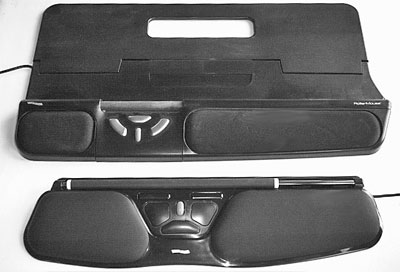
Old RollerMouse (top) and the new RollerMouse 2 (bottom)
While getting used to using a roller bar does involve scaling a bit
of a learning curve in the early going, once the muscle memory has been
developed and becomes intuitive, one begins to appreciate how quick and
effortless these devices can be. I wouldn't want to be without my
Contour RollerMouse.
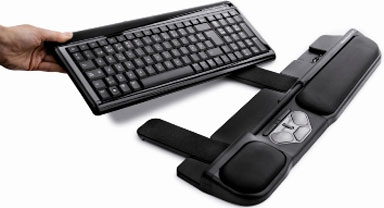 If you
suffer from mousing pain and haven't tried a roller bar, you really owe
it to yourself to check them out, but even if you have no pain or
repetitive stress issues with mousing, roller bars still offer some
significant advantages from an input efficiency perspective.
If you
suffer from mousing pain and haven't tried a roller bar, you really owe
it to yourself to check them out, but even if you have no pain or
repetitive stress issues with mousing, roller bars still offer some
significant advantages from an input efficiency perspective.
Roller bars are not very widely known compared with other
"alternative" pointing devices, especially trackballs and touchpads,
but they essentially consist of a round bar situated between the
computer keyboard and the user, who manipulates the screen cursor
through a combination of rolling the bar on its axis and sliding it
laterally back and forth in its housing. The rollerbar moves the cursor
by sliding left to right, up and down, and diagonally (simultaneous
slide and roll). Pressing the roller down vertically performs a single
click (there is also a central array of click buttons), and the bar
click function can modified if you install the RollerMouse software
driver. Otherwise, no driver installation is necessary for Mac OS X
10.1 or later.
RollerMouse 2 with i-Rocks Illuminated Keyboard
Roller bar operation is actually a lot more intuitive than it
sounds, and the theory is that roller bars reduce physical stress,
especially on the elbows and shoulders, by eliminating the reaching
necessary when using any mouse - whether conventional or ergonomic.
Contour Design's RollerMouse rollerbar station was developed in
Sweden and is designed to be used with standard computer keyboards that
have a rectangular form factor and a straight edge on the user side. I
find that Kensington's excellent
SlimType keyboard,1 the very similar i-Rocks Illuminated
Keyboard,2 and most recently the Logitech Rechargeable
Keyboard all work well with RollerMouse, but a wide selection of
keyboards are compatible.
It also can be used with a laptop.
RollerMouse 2 with 17" PowerBook
The roller bar can be manipulated using either hand or whatever
combination of thumb, fingers, and palm control is comfortable for the
user. This facility for spreading mousing stress between both hands and
various digits is a key element in reducing overall stress on the
user's body.
One aspect of roller mousing is inevitably running out of lateral
rollerbar travel before you reach the edge of the screen when mousing
slowly, in which case you just apply gentle pressure to toggle a switch
at the end of the bar's travel to continue cursor travel in the
direction you desire. This is similar to picking up a mouse and placing
it in the center of your workable area.
The RollerMouse Free2 features the following improvements over
previous versions:
- Keyboard lifters allow the user to adjust height and tilt of the
keyboard to a desired setting. I prefer my keyboard to be either flat
or slightly tilted away from me, and thin enough to be lower than the
wrist rest. I find the RollerMouse Pro2 works nicely with the
Kensington SlimType, as well as Logitech's thin diNovo (in USB and Bluetooth versions) and
Solar Wireless keyboards, but a wide selection of keyboards are
compatible, the prerequisites being a rectangular form factor and a
straight edge on the user side.
- Leatherette wrist supports (instead of the previously used foam
texture) make Pro2 more comfortable and easier to clean.
- Increased productivity with one touch copy, paste, and double click
supported.
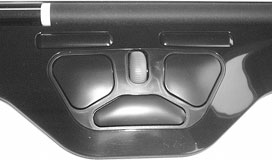 The
roller bar is now 67% longer and open to manipulation over its entire
length, rather than just through a central access aperture as was the
case with my old RollerMouse. Contour says this was done in response to
customer feedback that some larger-framed users felt they had to
"scrunch" their hands together in order to manipulate the shorter bar.
Extension of the bar to the right and away from the function buttons
was done at the request of many customers involved in Assistive
Technology so as to give users with motor impairment freer access to
the bar with minimal risk of inadvertent hitting a function
button.
The
roller bar is now 67% longer and open to manipulation over its entire
length, rather than just through a central access aperture as was the
case with my old RollerMouse. Contour says this was done in response to
customer feedback that some larger-framed users felt they had to
"scrunch" their hands together in order to manipulate the shorter bar.
Extension of the bar to the right and away from the function buttons
was done at the request of many customers involved in Assistive
Technology so as to give users with motor impairment freer access to
the bar with minimal risk of inadvertent hitting a function
button.
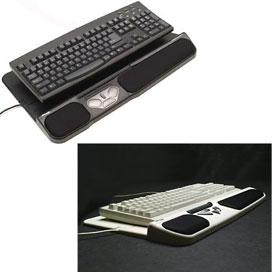
A minor criticism is that the RollerMouse has no USB repeater port,
so it eats up a USB port in your system. Unfortunately, this is a
pretty general trend in USB peripherals these days, but especially on a
device as expensive as the RollerMouse, it would be convenient to have
a USB repeater. I would also prefer a non- or switchably-detented,
weighted scroll wheel a la Logitech mice and a slightly lighter
effort for clicking with the roller bar.
In my estimation, the main downside of the RollerMouse is its price
- it lists at $219.95 for the Free2
model and $199.95 for the Pro2
model, quite a bit more than you have to pop for a good conventional
ergonomic mouse, such as the Contour
Mouse or many others. However, if the RollerMouse will facilitate
greater comfort and productivity at your computer, it could pay for
itself pretty quickly.
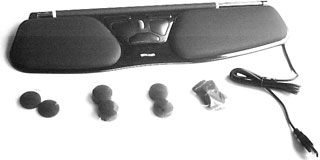
The high price is the main reason (along with the lack of a USB
repeater port ant that non-freewheeling scroll wheel) I'm not giving
the Contour RollerMouse Free2 a full four out of four rating, but
price-dependent it has to be three out of four.
Contour invites computer users from any US major industry,
education, government institution, as well as qualified home users
(some 30 day trials will require a valid credit card) to obtain a
30 day
free trial of their choice of Contour products.
- The white Kensington SlimType has been discontinued and replaced by
a newer
black model.
- The backlit white i-Rocks KR-6810 has been discontinued. The
closest replacement appears to be the KR-6421-WH
Ultra X-Slim Keyboard.


 If you
suffer from mousing pain and haven't tried a roller bar, you really owe
it to yourself to check them out, but even if you have no pain or
repetitive stress issues with mousing, roller bars still offer some
significant advantages from an input efficiency perspective.
If you
suffer from mousing pain and haven't tried a roller bar, you really owe
it to yourself to check them out, but even if you have no pain or
repetitive stress issues with mousing, roller bars still offer some
significant advantages from an input efficiency perspective. The
roller bar is now 67% longer and open to manipulation over its entire
length, rather than just through a central access aperture as was the
case with my old RollerMouse. Contour says this was done in response to
customer feedback that some larger-framed users felt they had to
"scrunch" their hands together in order to manipulate the shorter bar.
Extension of the bar to the right and away from the function buttons
was done at the request of many customers involved in Assistive
Technology so as to give users with motor impairment freer access to
the bar with minimal risk of inadvertent hitting a function
button.
The
roller bar is now 67% longer and open to manipulation over its entire
length, rather than just through a central access aperture as was the
case with my old RollerMouse. Contour says this was done in response to
customer feedback that some larger-framed users felt they had to
"scrunch" their hands together in order to manipulate the shorter bar.
Extension of the bar to the right and away from the function buttons
was done at the request of many customers involved in Assistive
Technology so as to give users with motor impairment freer access to
the bar with minimal risk of inadvertent hitting a function
button.


